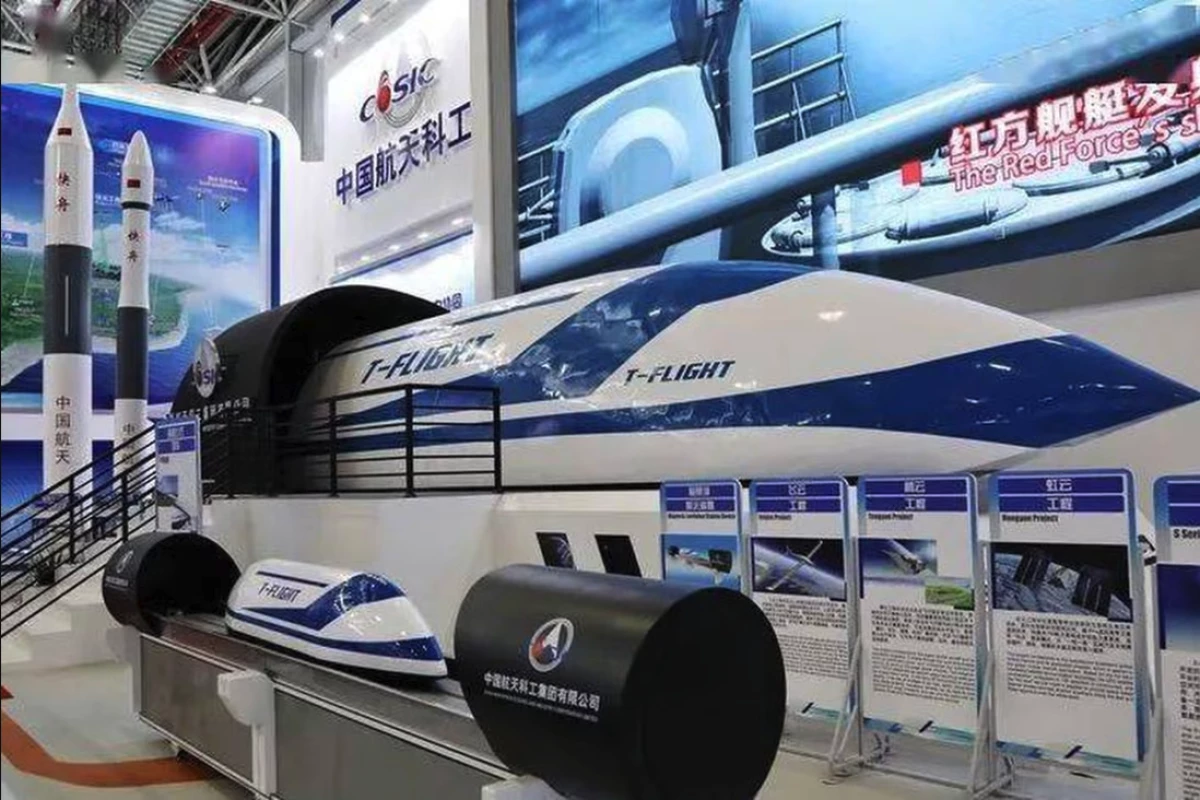China's biggest missile manufacturer is working on a hyperloop. CASIC claims it's clocked the fastest speed ever for a superconducting maglev vehicle – over 623 km/h (387 mph) – during tests in a low-vacuum tube just 2 km (1.2 miles) long.
Hyperloop trains have become more or less a punchline in certain parts of the tech world, shorthand for ultra-high-tech projects that make grandiose claims of immense speed and efficiency, while ignoring several large elephants in the room that leave them with little practical chance of success.
The idea is simple enough: take the vacuum-tube messaging systems of the 1800s, upsize them until they can fit whole maglev trains inside, then suck all the air out and blast those trains around at thousands of miles per hour, enjoying ludicrous levels of efficiency. There's no air drag or wheel contact to sap power and slow you down, so you can go Mach 5 through a long vacuum tunnel without so much as a sonic peep. New York to LA in a coffee and a dump.
Never mind that regular high-speed maglev trains and infrastructure are already hideously expensive to build and deploy, without needing hundreds or thousands of miles of perfectly air-tight tube, constantly being sucked at by vacuum pumps all day. Or the potential disaster if pretty much anything goes wrong at those speeds.
Still, it's one of those concepts that keeps popping up; Elon Musk famously proposed it, built one tiny example in Las Vegas, then farmed the concept out to other companies, one of which has just gone defunct. Indeed, Musk has been accused of whipping California and other states into a froth over the idea just to tank support for public transport projects.
China is one step closer to a cutting-edge transportation system involving a 1,000 km/h high-speed #maglev #train running in a low vacuum pipeline after newly completing the main structure of a 2-km full-scale test pipeline in N China's Shanxi, the longest of its kind globally. pic.twitter.com/rDv1NEQ20k
— China Science (@ChinaScience) November 23, 2023
Either way, there are companies still at it, and there's one that might have the right mix of population density, government co-operation and capital to get it done: China Aerospace Science and Industry Corporation, or CASIC. CASIC has built a 2-km test section of low-vacuum tube – the longest ever such facility – in Yanggao county, Datong, Shanxi province. For reference, if atmospheric pressure at sea level is about 1 bar, "low vacuum" is between 0.3 and 0.001 bar.
After numerous slower-speed tests over the last several months (one of which is the subject of the nine-month-old video below), the CASIC team recently sent its T-Flight "high-speed flier" down the track for its first stable magnetic levitation run, and while it's not yet releasing the exact speed, SCMP reports that it broke through the 623-km/h (387-mph) mark set last October for the fastest train run in history.
Let's break out the old back of the envelope for a second. Assuming we leave, say, about 500 m (1,640 ft) for safe stopping, that means the prototype vehicle might've accelerated at a little over 1 G – a tad quicker than freefalling, but without air resistance, for about 17 seconds before slamming on the brakes at about 3G of deceleration, however that works in a maglev situation. Or it might've accelerated significantly quicker at about 2G, hit its top speed halfway down the tube, then slowed down at a similar rate.
Either way, that is, as a man who sat in glitter might say, pretty nuts. CASIC says the flatness of its test track is within an 0.3 mm (0.01 inch) tolerance, that the 6 m (20 ft) diameter vacuum tubes have a geometric size error less than 2 mm (0.1 in), and that the entire pipeline can be returned to its normal pressure within five minutes.
CASIC is happy with this test, saying it validated the interaction between the test tube, the vehicle and the track. But it's certainly not done. Phase two calls for the track to be extended thirty-fold to 60 km (37 miles), which will allow the train to be tested at a target speed of 1,000 km/h (621 mph) – a decent whack faster than an airliner. After that, well, it might make sense to connect Datong with Beijing – a 346 km (215 mile), four hour-plus drive that might be slashed to less than half an hour in a hyperloop ride.
CASIC certainly has lofty and futuristic ambitions for the system – as the six-year-old video above shows, complete with a Wuhan-to-Beijing link claiming a 2,000 km/h (1,243 mph, or Mach 1.6) top speed. But the company seems to be realistic about the challenges and practicalities involved. This is a company that posted US$34 billion in revenue back in 2017, and the Chinese government certainly won't be wringing its hands over any landholder complaints or blue-bottomed grass frog habitats if it decides to get the thing built.
More importantly, China's colossal population - 1.412 billion and rising – makes it one of the only countries in the world where public transit systems of this outrageous expense might be somewhere close to financially possible.
It's hard to know what to make of this thing, or how many grains of salt to take with it. For all we know, this might be an advanced railgun propulsion test by one of China's key military suppliers; CASIC is China's largest missile manufacturer, as well as a key contributor to the country's space program. But it seems it's also the world's leading hyperloop vacuum train company, with daylight second.
We'd love to see what 620-plus km/h looks like in some video, but it's unlikely; neither the outside nor the inside of a big white vacuum tunnel probably looks all that interesting.
Source: South China Morning Post





